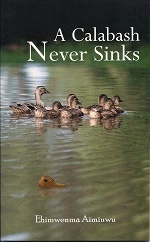
Leaders and priests of all the Idu deities agreed that while they should continue with their various individual efforts to reach Osanobua, they should also come together regularly to plead and pray with one voice for Osanobua’s direct intervention and blessings in their lives. They each first went through self purification processes such as fasting and spiritual cleansing, and collectively cleansed the place chosen for the prayer gathering. The prayer sessions at the gathering point, went on regularly for a long while without any noticeable change in their plight, so one day, one of them, a powerful spiritual leader and priest by the name Okhuaihe, offered to take the people’s prayers and pleas to Osanobua in heaven. That meant dying for the uplift of his people, of course. The Idu people reluctantly agreed with him and promised to continue to pray at the chosen spot until he returned, or forever if he failed to return.


They continued praying at the same spot regularly for years and still Okhuaihe did not return and there was no visible change in their circumstance. Droughts were still ravaging the earth and many were dying helplessly from hunger and diseases. To mark the prayer spot, they planted the Uwerhien ‘otan tree, and heaped earth at its base to create a shrine to Osanobua. This was the only spot where direct prayers were offered to God in Idu land. At every other shrine, whether at home or in communal settings, they prayed through their ehi and deities. Still, Okhuaihe did not come back but one day, darkness fell on earth at noon. A huge ball of fire descended from the sky and with it came a thunderous voice confirming the presence of Osanobua and suggesting that Okhuaihe’s mission had not been in vain. The voice said: “Okhuaihe delivered your message to me, but your wishes are against my creative will and I will not grant them.”
A while after the voice spoke, another ball of fire descended from the sky through the darkness and fell on earth to lift the darkness. Idu people were expecting Okhuaihe to return with the lifting of darkness but he didn’t, so they declared that: Aimi ‘ose no ye ‘rinmwin.” Meaning life after death is beyond understanding. Idu people, however, consoled themselves with the thought that the new ball of fire from the sky must have brought a message from Osanobua. They organized a search party to locate where it fell and what it was. At the spot where the ball of fire fell, at the junction of Igbesanwman and today’s Aruosa Street, they found a strange huge black stone. The unique black stone, which looks alien to our world, is one of the relics the British took away during their sacking and burning of Benin City in 1897. Idu people named the stone ‘Aruosa,’ meaning the Eye of Osanobua (God) watching over His creation. It is a symbol of Idu people’s direct experience of God. They built a proper house of worship at the spot where they had always gone to pray to Osanobua. This happened over 3000 years ago. The ancient site is at a place known today as Akpakpava Road. Therefore, nobody can teach Idu (Edo) people anything about how to worship God. They knew and heard directly from God, thousands of years before the Christian era.
Aruosa doctrine is described as Godianism, meaning, direct one-on-one interaction with God. It requires no intermediaries, Messiahs or Redeemers. Aruosa’s body of beliefs, teaching and practices have not changed in thousands of years. Their preaching is pre-occupied with what they describe as the saga of creation by Osanobua. In worship, they invoke the presence of God with songs and by cleansing and sanctifying themselves. Ihonmwen ‘egbe n’ Osa mwen, meaning, “I purify myself for my God.” They pray and dance to their songs, using traditional musical instruments, including drums and the ukuse, to produce their music. They believe the sounds of drums, songs and dance help to invoke the spirit of God. Prayers are rendered in songs and a typical one goes like this:
“We believe in God
and we serve Him
because we abhor quarrels
bitterness, sickness,
death and poverty.”
A popular closing song goes like this:
“God, we
have made time to serve you,
Give us the time and blessing
to achieve our goals.”
Worship is on Sundays (the African veneration day), from 10 am to 12 noon. Aruosa is ruled by a Council of Elders under a Chairman who is the ‘Ohen Osa Nokhua,’ (Chief priest/ Pope). The current Ohen Osa is Col. Paul Osakpamwen Ogbebor (Rt.). The patron of the Aruosa is the Oba of Benin. The Aruosa’s Ohen Osa led a delegation of Aruosa priests to Portugal in 1462, during the reign of Oba Ewuare. The Aruosa priests picked up a few ideas about mode of dressing which they adapted. They were surprised that baptism and confirmation in the Catholic Church played similar roles as the Aruosa initiation rites into the lower and upper sanctum of the Aruosa faith. Initiation at the level of baptism in Aruosa is not with water as in the Catholic faith, but with the white chalk (orhue), which is the symbol of cleanliness, purity, joy, and success. The equivalence to confirmation initiation rites in Aruosa, use palm fronds (igborhe), which is the symbol of renewal of life, multiplicity and endlessness. Christians use palm fronds in their Palm Sunday rituals as a symbol of renewal of life but deride Africans they copied from, as primitive and savage for using them.
The British, after conquering and burning Benin City, banned the worship of the Supreme God at Aruosa, describing the practice, which is not only superior to their concept and mode of worship, but older by thousands of years, and from which they took their religious bearing, as barbaric. Oba Akenzua II, defied the British ban in 1945, by building the first Aruosa Cathedral on the ancient Aruosa site at Akpakpava Road, which the Roman Catholic Church had usurped before that time to erect their Cathedral. Akenzua II set up 12 Aruosa schools in Benin City, Urora and other places, to spread the teaching of the faith. Through his influence, Aruosa houses of worship were built in Onitsha, Umuahia, and Port-Harcourt, as well as in Cotonou in Benin Republic. The Nigerian civil war truncated the gains made by Aruosa during Akenzua’s reign. The military regime seized all mission schools, including the Aruosa’s, and ran them aground.